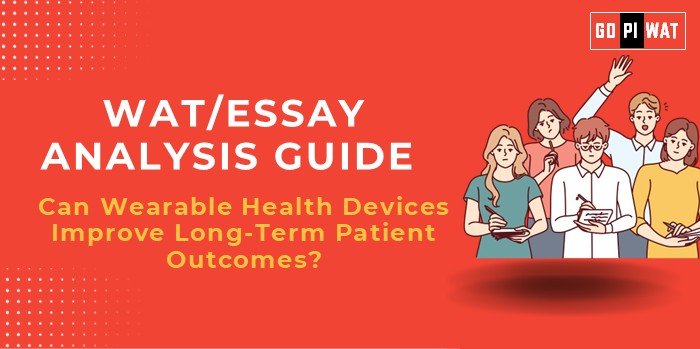📋 WAT/Essay Analysis Guide: Can Wearable Health Devices Improve Long-Term Patient Outcomes?
🌐 Understanding the Topic’s Importance
Wearables sit at the intersection of healthcare innovation and patient empowerment, making them critical for essays exploring healthcare modernization, tech applications, and preventive care models.
🛠️ Effective Planning and Writing
- Time Allocation:
- Planning: 5 minutes
- Writing: 20 minutes
- Review: 5 minutes
- Preparation Tips:
- Note key statistics and recent innovations.
- Highlight stakeholders and their interconnections.
✍️ Essay Structure
Introduction Techniques:
- Contrast Introduction: “While wearables promise health monitoring convenience, they raise concerns about accessibility and data privacy.”
- Solution-Based Introduction: “Wearable devices could revolutionize healthcare by bridging gaps in monitoring and treatment adherence.”
Body Paragraphs:
- Achievements: Cite examples like Apple Watch’s role in detecting AFib.
- Challenges: Address data privacy and cost barriers.
- Future Outlook: Emphasize AI advancements and global collaborations.
Conclusion Templates:
- Balanced: “Wearables can transform healthcare if challenges like privacy and access are systematically addressed.”
- Global Comparison: “Countries like Japan and the U.S. showcase wearable potential; lessons from these examples could drive wider adoption.”
📊 Recommendations for Sustainable Progress
- Strengthen regulatory frameworks to ensure data security.
- Develop affordable devices for low-income populations.
- Foster public-private partnerships for broader access.
✨ Sample Short Essays
- Balanced Perspective: “Wearables have significantly improved healthcare monitoring but require advancements in security and affordability to maximize impact.”
- Solution-Oriented: “Affordable and secure wearable technology can revolutionize long-term healthcare outcomes, particularly for chronic disease patients.”
- Global Context: “Wearables have shown success in developed nations; expanding access in low-income countries could save millions of lives.”


